Students in the International Training and Education Master's Program Travel to Japan
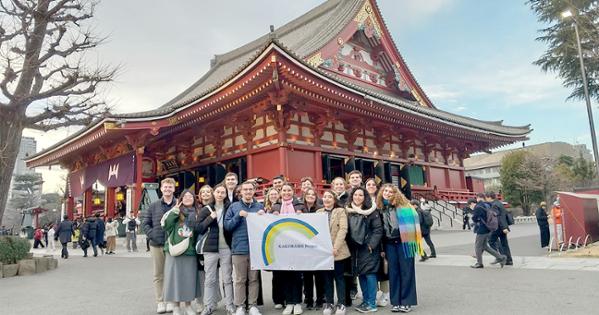
Ansilta De Luca ’25 and Maddy Crawford ’24, students in the School of Education’s International Training and Education Program (ITEP), along with another student from American University’s philosophy department, traveled to Japan as part of the KAKEHASHI Project for Young Researchers in January. The program, sponsored by Japan’s Ministry of Foreign Affairs, creates and enhances friendship ties between Japan and North America by exposing researchers and students to the many facets of Japan’s society and culture. The participants were selected based on their background working with Japanese culture, interest in the language, and plans to work in the country in the future.
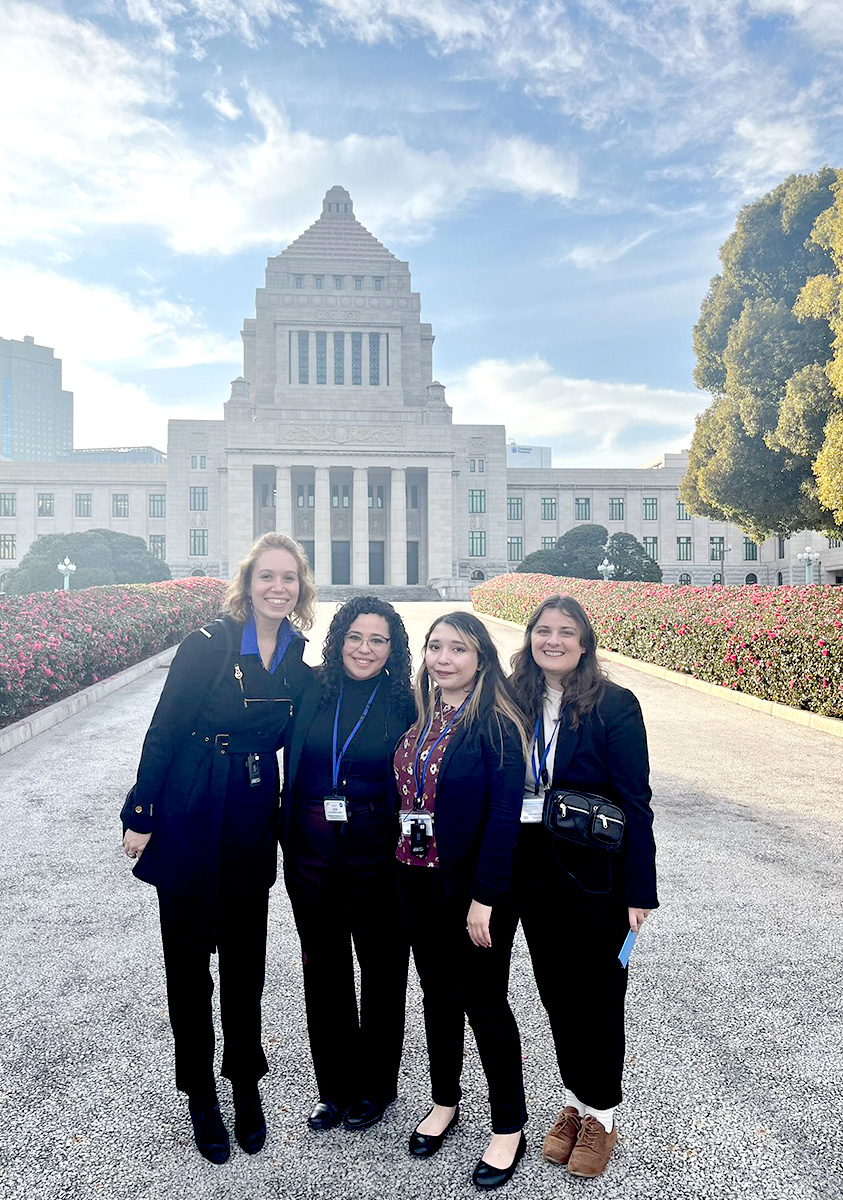 Photo: Ansilta De Luca (far left) and Maddy Crawford (far right) in front of the Ministry of Foreign Affairs in Tokyo.
Photo: Ansilta De Luca (far left) and Maddy Crawford (far right) in front of the Ministry of Foreign Affairs in Tokyo.
De Luca is specializing her studies in multilingual adult education and currently working with a law firm in Japan as an in-house corporate trainer. She works with students to help them understand nuances of the English language and be better equipped to manage social and business situations. She credits the program as being a great support in her pursuing a specialization in multilingual education and cross-cultural communication, and she values the continued involvement in international experiences.
Crawford graduates this spring with a specialization (concentration?) in higher education internationalization, particularly studying abroad and short-term exchanges between the US and Japan. Crawford had stayed in Kyoto, Japan, as part of a Boren Fellowship where she studied Japanese language at Ritsumeikan University. “Participating in the Kakehashi Project was a wonderful way to experience first-hand the implementation of an exchange that would be very similar to the kind of program I would like to work on in the future,” she said. She believes this program also gave her greater insight into different aspects of Japanese culture and international relations.
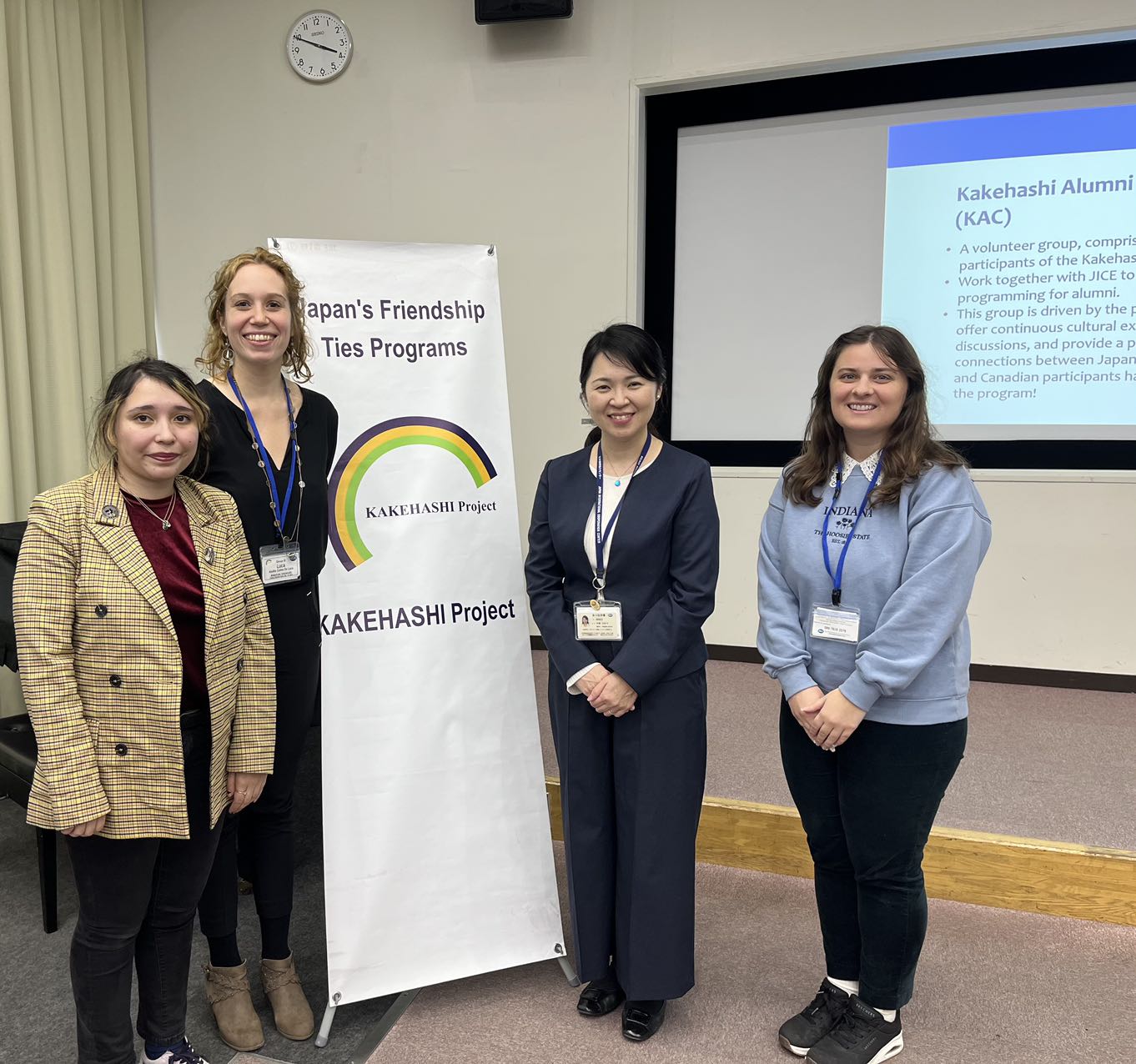 Photo: Ansilta De Luca (second from left) and Maddy Crawford (far right) with the President of the Japanese International Cooperation Center (JICE) in Tokyo.
Photo: Ansilta De Luca (second from left) and Maddy Crawford (far right) with the President of the Japanese International Cooperation Center (JICE) in Tokyo.
The students began their exchange in Tokyo, adhering to a fast-paced schedule giving participants experiences from diverse districts and facets of the city for three days. They toured the National Diet building and explored Sensoji, one of Tokyo’s oldest and most important temples.
They were also given a guided tour of the Japan Rail control center, where the complex train schedules of Tokyo are created and managed live. The variety of places that the students visited was not only impressive but also gave an in-depth look into Japanese culture and government, and the day-to-day lives of its inhabitants. Participants had a chance to try new foods at every meal, including specialties of Tokyo and of the rural regions of Toyota. “Trying the salted sweetfish, ayu no shioyaki, for the first time was daunting; I had never eaten this style of fish before but it was delicious,” said De Luca.
 Photo: “The salt-grilled sweetfish, ayu no shioyaki, are skewered on a curve to make them appear as though they are still swimming against the current.”
Photo: “The salt-grilled sweetfish, ayu no shioyaki, are skewered on a curve to make them appear as though they are still swimming against the current.”
On the fourth day, the group traveled by bullet train and chartered bus to the remote city of Toyota in Aichi prefecture, famous for car manufacturing and beautiful autumn foliage. After sampling the local salt-grilled sweetfish and rice cakes, they learned traditional bamboo weaving techniques in Meiji-period (1868-1912) farm houses. “This was a unique experience, learning from the local artisans, and it was incredible to get the chance to try it out ourselves,” said Crawford. “Though challenging, we were all able to weave coasters from thread and bamboo. The artisans were incredibly engaged and willing to sit with the students and help them at each step, taking the time to explain how the loom worked and what some of the tricks were to get a better-looking design.”
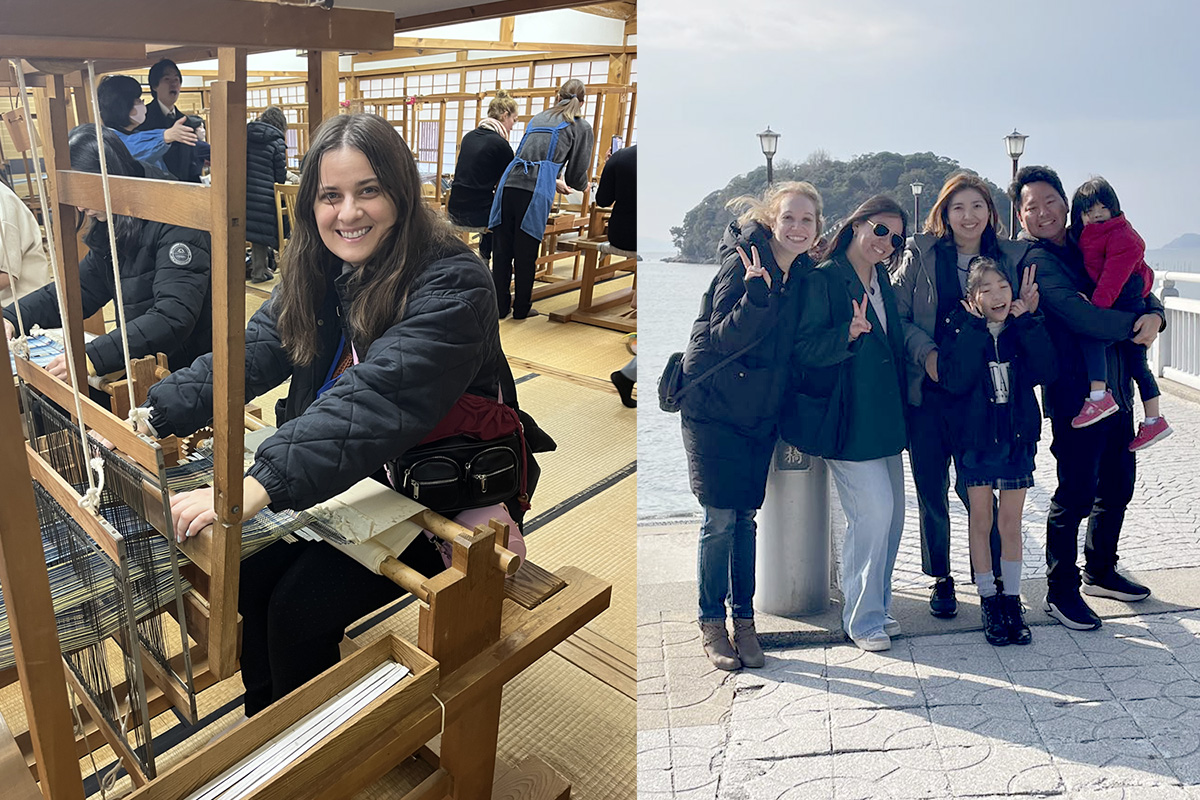 Left Photo: Crawford weaving bamboo-strand coasters on a traditional loom at the open air museum Asuke Yashiki in Toyota city.
Left Photo: Crawford weaving bamboo-strand coasters on a traditional loom at the open air museum Asuke Yashiki in Toyota city.
Right Photo: Ansilta De Luca with her host family, the Koyas, in the city of Gamagori.
The program included a home stay experience in Toyota. The host families went to great lengths to make students comfortable in their homes and put a premium on building meaningful relationships during their time together. Families met the students holding ‘Welcome to your home in Japan’ signs and welcomed everyone with hugs and gifts. For the children in the host families, this would be an experience that they would remember forever with countless stories of singing karaoke, visiting temples, dressing in traditional outfits, and enjoying delicious meals together. “I’ll never forget the sight of families gathered around us saying goodbye,” said De Luca. “The children clung to the students and mothers and fathers gave us tearful hugs. The sense of community and impact we had on each other was incredibly strong. I couldn't have asked for a more beautiful and wholesome experience.”
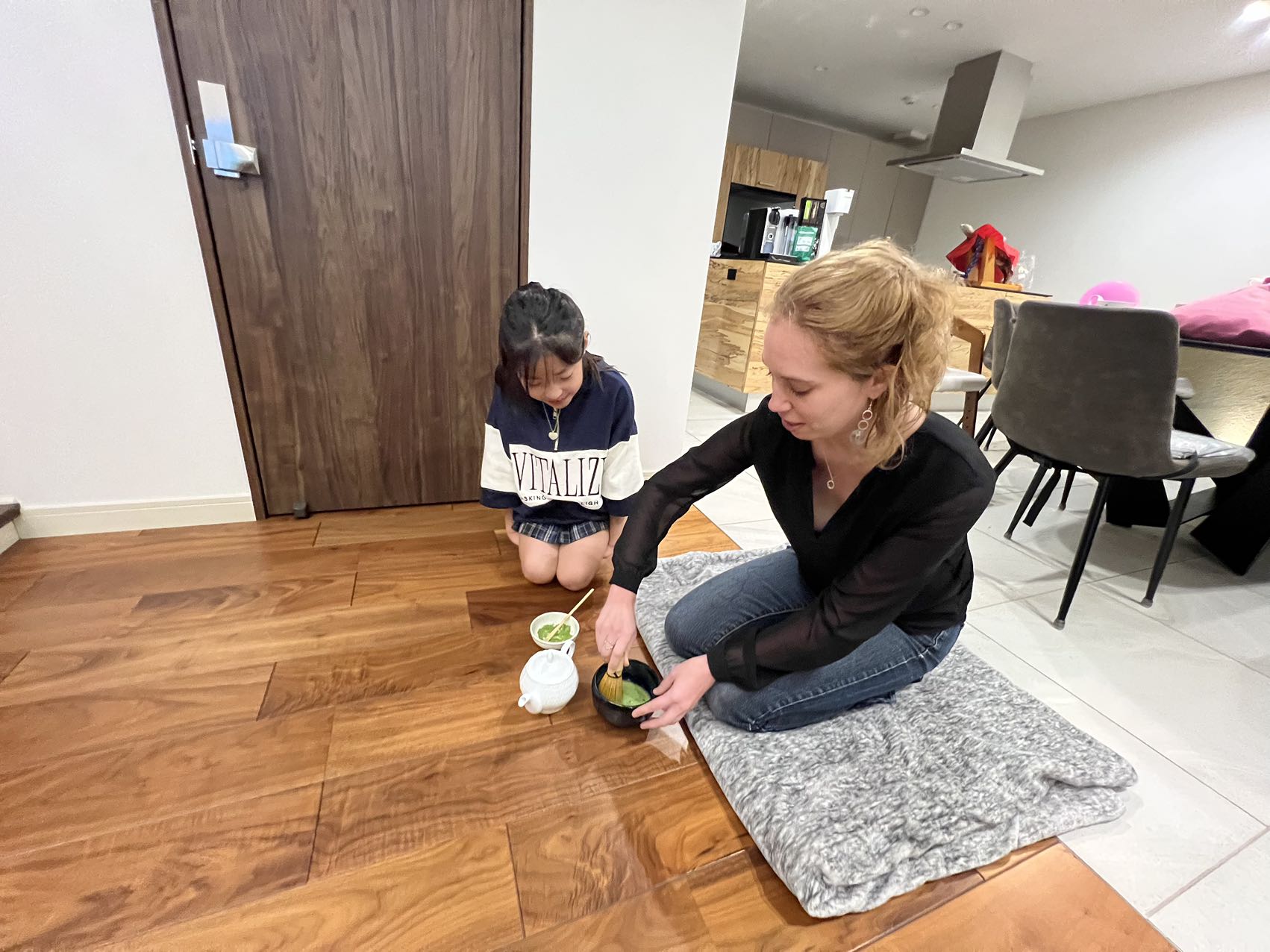 Photo: De Luca learning about a traditional tea ceremony from her host sister, Hima.
Photo: De Luca learning about a traditional tea ceremony from her host sister, Hima.
Students learned about an array of Japanese traditions while in their homestays. De Luca, pictured with her host sister, learned the steps for making the tea and practiced conducting the ceremony. The ceremony was something her host sister learned about in school and she was excited to share this tradition with De Luca and explain the nuances and meaning behind every step. She began by demonstrating the entire ceremony and then allowed for her visitor to try it on her own, giving very specific instructions along the way. “It was a joyful experience for us to both learn from each other and it gave the young girl a chance to show off what she had learned and how proud she was to share that with another person,” said De Luca. Hima told her parents, “I can’t wait to tell my friends at school.” Hima’s parents beamed with pride as they watched their daughter deliver the ceremony and enjoyed recording moments between the daughter and student as they worked together to translate the steps and explain in detail how to proceed. “The family was incredibly open to sharing their culture and wanted me engaged in everything,” De Luca said. “My host sister was over the moon about having us stay there and was thrilled to be able to teach me something that was so important to her.”
Crawford’s host family shared their favorite winter experiences, including fried sweet potato, warm tea, and playing games like Uno around a kotatsu, a heated blanket table. “We slept in cozy, traditional futons on top of straw-woven tatami mats and woke up to a delicious homemade breakfast of salmon-stuffed rice balls called onigiri,” she recalls. Afterward, Crawford visited a community group the host family is a part of called the HIPPO Family Cultural Center, where the children of the families taught her traditional dances and games. “The hospitality and ways of life that the mom, dad, and two young boys showed me was a truly amazing and moving experience. I felt like a part of their family.”
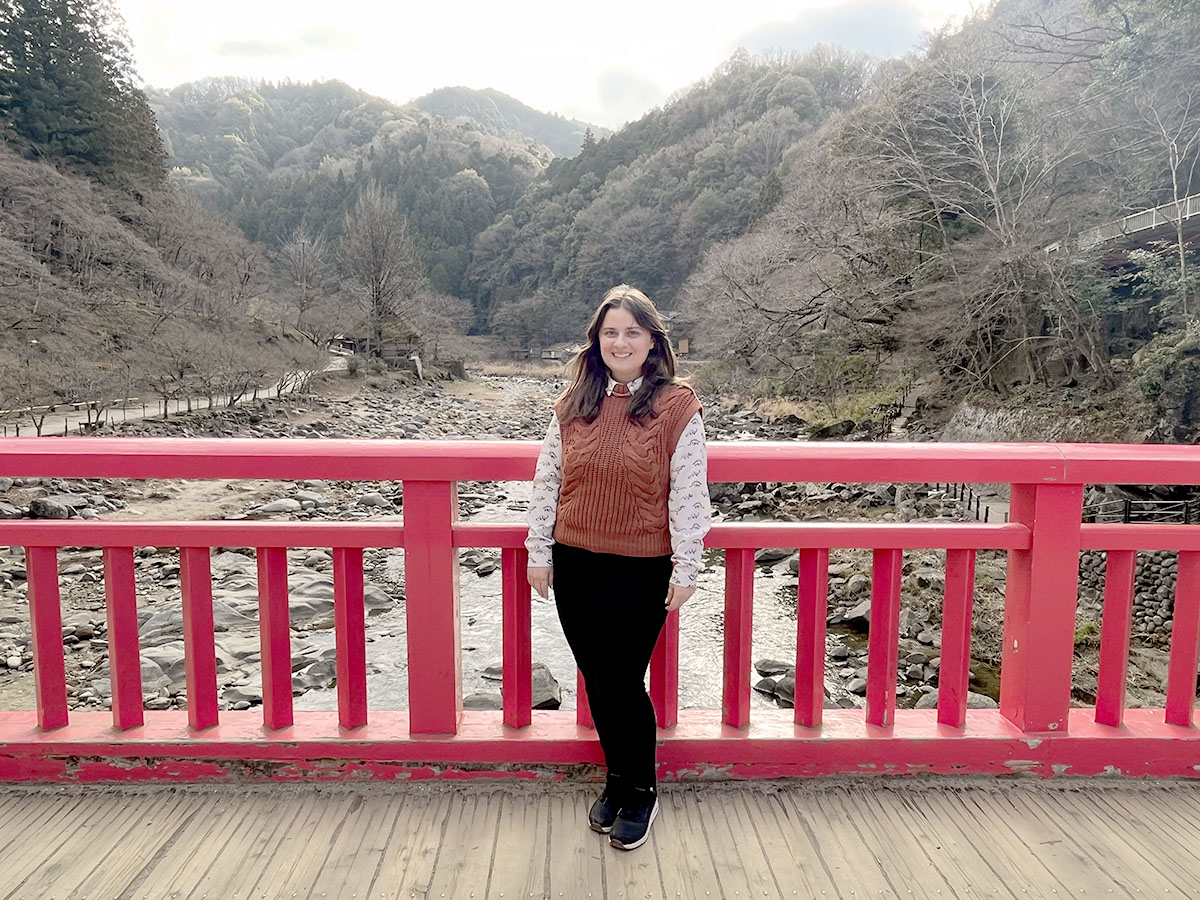 Photo: Crawford on the Taigetsu Bridge, a popular sightseeing spot for the Koraneki Gorge in Toyota city
Photo: Crawford on the Taigetsu Bridge, a popular sightseeing spot for the Koraneki Gorge in Toyota city
The intensive cultural immersion aimed to define friendships and by the end of the trip, meaningful bonds developed both with the families and the staff from the program. Students were exposed to a variety of cultural experiences and given the opportunity to explore and engage in a way that would have never been possible without the support of the JICE program.
“Moving forward, I will continue to work closely with the Japanese law firm and look forward to the possibility of returning to Japan in the future to continue cultural and language exchange. This program has demonstrated the importance of cross-cultural involvement and has encouraged me in my international training studies which will allow me to continue working abroad with a variety of cultures, hopefully again with Japan,” De Luca said.
“I hope to use the expanded perspectives on Japanese society and culture in my research on intercultural exchange between Japan and the US,” said Crawford. “In the future, I would love to help organize and facilitate similar programs for students, and the things I’ve learned and relationships I’ve made on the Kakehashi Project will be invaluable for any future work I do that involves Japan.”
- Inquire to become a School of Education’s International Training and Education student
- Learn more about the School of Education’s International Training and Education Program
- Read testimonials from alumni of the International Training and Education Program
